STOCKBRIDGEMASSACHUSETTS |
 |
STOCKBRIDGEMASSACHUSETTS |
 |
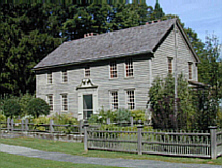 |
MISSION HOUSE MUSEUM The house of the Reverend John Sergeant, first missionary to the Stockbridge Indians. Built in 1739. (Mission House Marker) |
Lenox and Stockbridge are two very popular towns in the Berkshires. They both have a small-town feel and a physical charm that draws people to them, especially in the summer. A walk around the town of Stockbridge is recommended.
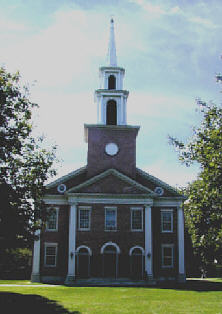 Stockbridge
was established in 1739 by the Yale-educated John Sergeant and his wife,
Abigail, who was the daughter of Ephraim Williams, founder of Williamstown
and home of Williams College. The Sergeants came to Williamstown to educate and
“redeem” the local Mahican Indians. However, settlements in the area
gradually displaced the Native Americans. Shortly after the end of the
Revolutionary War, they moved on to the Oneida Reservation in New York State.
Stockbridge
was established in 1739 by the Yale-educated John Sergeant and his wife,
Abigail, who was the daughter of Ephraim Williams, founder of Williamstown
and home of Williams College. The Sergeants came to Williamstown to educate and
“redeem” the local Mahican Indians. However, settlements in the area
gradually displaced the Native Americans. Shortly after the end of the
Revolutionary War, they moved on to the Oneida Reservation in New York State.
The Mission House can be found about a block west of the Red Lion Inn. Today, the house is a museum. It is surrounded by an 18th century herb and flower garden.
Stockbridge was home to the African American, Revolutionary
War soldier, Agrippe Hull. He served as an aide to Polish General Thaddeus
Kosciuszko, who skillfully engineered many of America’s defensive positions,
including those at Saratoga. After the war, Hull worked in Stockbridge for
Congressman Theodore Sedgwick.
Breakfast in Stockbridge -- Downtown Stockbridge was once the location of
the legendary Alice’s Restaurant. 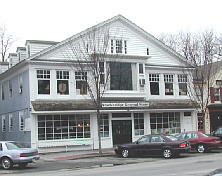 The
restaurant was made famous in the 60’s by a song written and sung by Arlo
Guthrie. The song, Alice’s Restaurant, was later made into a movie, also
filmed in Stockbridge.
The
restaurant was made famous in the 60’s by a song written and sung by Arlo
Guthrie. The song, Alice’s Restaurant, was later made into a movie, also
filmed in Stockbridge.
Park near the Red Lion Inn in the center of Stockbridge. The inn was opened during the Revolutionary War as Bingham’s Tavern. The original structure was destroyed by fire.
Although it’s not Alice’s Restaurant, the Main Street
Café is a great spot for breakfast. The café is a block east of the Red Lion
Inn on Main Street.
Knox Trail Marker in Nobletown, New York -- The New York Knox Trail marker has a map on it that shows the route taken by General Knox. The route includes Fort George (Lake George, NY), Fort Edward, Saratoga, Half-moon, Albany, Kinderhook, Claverack, Nobletown and finally Cambridge.
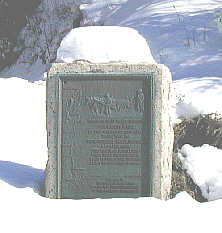 |
Through this place passed Gen. Henry
Knox in the winter of 1775-1776 to deliver to Gen. George Washington at
Cambridge the train of artillery from Fort Ticonderoga used to force the
British Army to evacuate Boston. Erected by the State of New York during
the Sesquicentennial of the American Revolution.
(Nobletown Marker) |
Knox left Fort Ticonderoga on December 9, 1775. He reached this point about January 13, 1776. He had spent Christmas in Glens Falls, NY and New Years in Waterford, just north of Albany. He lost several days in Waterford waiting for the ice to thicken in order to cross the Mohawk River.
At this point, which is referred to as Nobletown on the marker, Knox had completed about half of his journey to Boston. He still had to cross Massachusetts, but more immediately, he had to cross the Berkshire Mountains. One of Knox’s biggest challenges was still before him.
Shays’ Rebellion Marker, Sheffield, Massachusetts -- On February 27, 1787, one of Shays’ rebel group leaders, Captain Perez Hamlin battled Colonel John Ashley, the largest landholder in the area. Hamlin and his rebels had just finished ransacking the town of Stockbridge when Ashley caught up with him. The sides were fairly evenly matched with nearly 100 men on each side.
Within the first ten minutes of the bloody battle, there were 34 casualties, five of which resulted in death. Most of the casualties were rebels.
Ashley, with additional help from reinforcements led by General Paterson from Lenox, was able to defeat the rebels and take the remaining men as prisoners.
The marker at the site of the battle indicates that this was the last battle of Shays’ Rebellion. Although other skirmishes did occur, there is no doubt that this was the last of the major battles.
If one considers Shays’ Rebellion to be the last battle of the Revolutionary War — the Revolutionary War ended here.
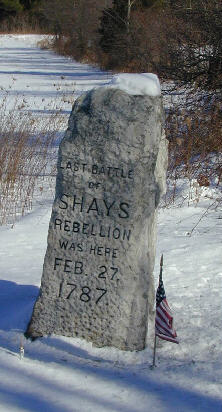 |
Last battle of Shays’ Rebellion was here, Feb. 27, 1787. (Sheffield Marker) |
